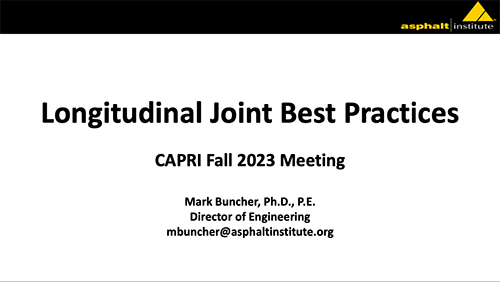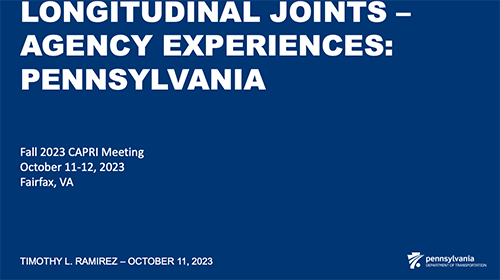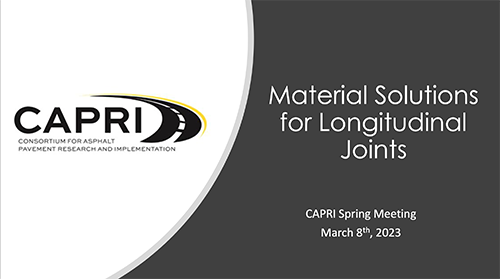Longitudinal Joints
Longitudinal Joint Resources
This list contains links to external pages that have valuable information about Longitudinal Joints on asphalt pavements.
Longitudinal Best Practices One Pager
The five pages in the appendix above provide a summary of the recommendations from a joint FHWA/Asphalt Institute project on Longitudinal Joint Best Practices.
Longitudinal Joint Information - Asphalt Institute
FHWA Tech Brief: Improving Longitudinal Joint Performance
Pavinar: Longitudinal Joints in Asphalt Pavements (Video)
Constructing a quality bituminous longitudinal paving joint (Video)
Meeting Presentations
Click on the images below to view or download presentations.
Ohio’s Longitudinal Joint Specifications,
presented by Eric Biehl, P.E., asphalt materials engineer, ODOT Office of Materials Management, at the Fall 2023 CAPRI meeting, October 2023.

Ohio’s Longitudinal Joint Specifications Contractor Perspective,
presented to CAPRI by Bart A. Moody, P.E., V.P. of Asphalt Estimating and Engineering, Kokosing Construction Co, Inc.)
The Ohio Department of Transportation (ODOT) successfully implemented a longitudinal joint density specification to improve the life of their pavements. ODOT involved their partners from the paving industry in the development of the specification, which allowed contractors to perform voluntary trials and ultimately led to a performance-based specification that both parties understood. This cooperation reduced the risk to the contractors which prevented unnecessary price increases to ODOT.

Longitudinal Joint Best Practices,
presented by Mark Buncher, Ph.D., P.E., director of engineering at Asphalt Institute, at the CAPRI Fall 2023 Meeting, October 2023

Longitudinal Joints – Agency Experiences: Pennsylvania,
presented by Timothy L. Ramirez, P.E., Engineer of Tests, PennDOT, Bureau of Construction and Materials, at the Fall 2023 CAPRI meeting, Oct. 11, 2023.
In 1995, the Pennsylvania Department of Transportation (PennDOT) participated with NCAT on a project to evaluate different asphalt mixture longitudinal joint construction and compaction techniques. The techniques have performed well since 1995 (28 years). From 2007 to 2009, PennDOT studied longitudinal joint density results from core samples collected on trial projects, implemented best practices, and then in 2010, successfully transitioned to a PWL-based incentive/disincentive longitudinal joint density specification. Since 2010, the lower limit for PWL was increased, and the incentives/disincentives and corrective actions were revised. This specification resulted in recent yearly statewide average longitudinal joint densities ranging from 92.8% to 93.5%. In 2018, PennDOT began evaluating Void Reducing Asphalt Membranes (VRAM) for improving the performance of longitudinal joints in asphalt pavements.

Improving Performance of Longitudinal Joints in Airfield Asphalt Pavements,
presented by Randy West, Airport Asphalt Pavement Technology Program, July 2022 to June 2024.
This presentation summarizes an ongoing project for the Airfield Asphalt Pavement Technology Program to evaluate methods for improving the performance of longitudinal joints on airfield pavements. FAA and military airfield specifications currently require the cut-back method for constructing longitudinal joints and have joint density requirements for acceptance based on cores taken on the joints. The project team has completed a literature review and has begun field evaluation of existing airfield and highway projects built using Void Reducing Asphalt Membrane (VRAM) and other products or techniques.

Minnesota HMA Longitudinal Joint Construction,
presented by Jerry Geib to CAPRI in March 2023.
MnDOT has great success with echelon paving to produce a great longitudinal joint. However, echelon paving is not always possible. The use of a Void Reducing Asphalt Membrane – VRAM, product is my preferred method when echelon paving is not possible. The Maryland joint compaction method with a joint adhesive product is also an option. Take a look at what MnDOT has done to improve the longitudinal joint.

Material Solutions for Longitudinal Joints,
presented by Katie DeCarlo, CAPRI Spring Meeting, March 2023.
Longitudinal joints can fail prematurely for several reasons including low density, high permeability, segregation, improper overlap, and lack of adhesion at the interface. Heritage took a materials approach to improve longitudinal joint performance from the bottom-up and top-down. This presentation provides information on Void Reducing Asphalt Membrane (VRAM), which involves applying a heavy band (~ 18” wide) of polymer-modified asphalt to the area where the new joint will be centered. It can help to fill voids from the bottom up, reducing water intrusion at the joint and protecting underlying pavement layers. Meanwhile a top-down approach can be taken by applying Rapid Penetrating Emulsion (RPE) to the surface of the joint. RPE is an asphalt emulsion that contains about 30-40% asphalt content and is designed to penetrate voids in an asphalt pavement. After penetrating, it leaves a minimal, temporary emulsion residue and reduces air and water intrusion while still maintaining adequate pavement texture. In other words, RPE is “in” the pavement instead of “on” the pavement.
